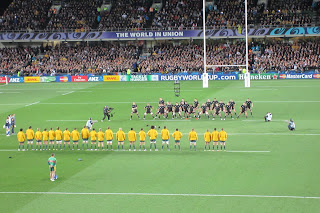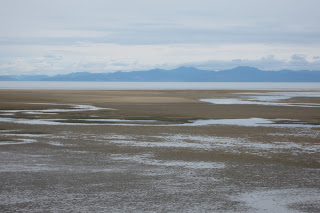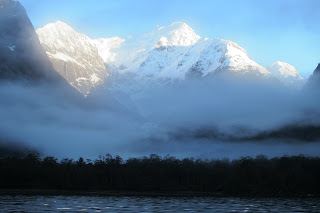The Kiwi's love nature and the outdoors, and there are nine "Geat Walks" throughout the country. These are 30 to 40-mile long nature trails that wind through some of the most beautiful, and unspoiled scenery in the world. The Milford Track, the Routeburn Track, and the Kepler Track are considered three of the best, and are all reasonably close to Queenstown. A lot of the scenes from the Lord of the Rings movies were filmed here, and some of it looks almost unreal.
I really want to do one of these, but my challenge is that it's a little early in the season, and the routes aren't officially open yet (though they are never formally closed). There was a lot of late-season snow, and the avalanche risk-level is "extreme". The Department of Conservation, or "DOC", manages the camping "huts" along the tracks, and advises against going out on the tracks at this time. Besides that, however, there are no transportation services to the Milford or Routeburn trail-heads. For example, if you wanted to do the Milford Track, you start with a half-hour bus ride from Te Anau to a boat dock on lake, then take an hour-long boat ride across the lake to the start of the trail. The 33-mile trail ends in a wilderness area at the mouth of the Milford Sound, but you have to make private arrangements for a boat to pick you up there in advance - something like "meet me on the sand bar by the big rock on the left side of the mouth next Tuesday". And then, you have to arrange for a ride back to Te Anau. Well, with the avalanche warnings still in effect, none of these services are even operating.
The Kepler Track, however, is a 37-mile mountain loop that begins and ends at a trail-head right outside Te Anau. It's designed as a 4 day hike through several mountain peaks, with overnight camping huts located at the end of each day's hike. In the mountains, no camping is allowed outside of the huts, and you have to register a hiking plan with the DOC and buy a camping pass for each night in a hut. The middle part of the track is impassable now due to snow, but, they say you can get to the first hut just below Mt. Luxmore.
It's 8.6 miles to the Luxmore hut, and the elevation is at 3,600 feet. They say that it usually takes a fit hiker about 6 hours to cover the distance at a reasonable pace, but they also said that there was some "winter damage" on the trail near the tree-line, so it might take a bit longer. Since this is my only option, I'm going to do an over-nighter. Up to the Luxmore hut on day one, spend the night, and come back down on day two. Since the trails aren't officially open, the hut is un-manned, and there is no water, electricity, or gas. I have to pack-in and pack-out everything I'm going to need, and when I filed my plan with the DOC, there were only two other guys scheduled to be there for the night.
The trail starts at lake-level, and for the first two hours, it's pretty easy going as you walk along the Fiordland National Park side of the lake.
Just past this beach, the trail goes into the forest, and up. And up. And up.
For the next six hours, every single step is up-hill. Swithch-back after swithch-back, and the forest is so think that you can't see much more than tree trunks and the green canopy of leaves. Then, I came upon this small opening. The picture above is looking down on Te Anau.

Winter trail damage. There are some improvements to the trails in the areas that are particularly dangerous, or see a lot of erosion. The walkway is installed here because you're walking along a 45 degree slope - it's really, really steep. Even though there are a lot of trees, if you lose you footing and fall, you could tumble down-hill for hundreds of yards. It's not unusual here to have "tree-slides" along the cliffs where whole sections trees and vegetation come sliding down face of the mountain when the sheer gravity of their weight overcomes the ability of their root systems to hold on to the rock or land. This one might not look so bad, but think about climbing over this muddy path by yourself with a 40 lb backpack, and knowing that it might be hours or days before someone else comes along to help you if you fall.

About 6 hours into the hike, I finally cleared the tree-line, and can see the top of Mt. Luxmore (4,600 ft). You cannot imagine the scale. When I looked up, I thought "holy crap, it's going to take another 5 hours to get to the top of that".
Fortunately, the Luxmore hut was only another hour's hike away. But, the trail was occasionally covered in waist-deep snow.
The huts are simple shelters. A couple of dorm rooms with bunks and mattresses, chemical toilets, and a main room with a wood-burning stove for heat and 5 or 6 separate cooking stations that each have a sink and a stove with a couple of gas burners. No showers, and since it's still early, the electricity, water, and gas haven't been turned on yet.
There were two French guys here when I arrived, and later on, a German couple showed up. I had a bottle of wine with me, and the Frenchmen had some hard liquor. We all cooked whatever we brought for dinner on our little camping stoves and had a great conversation. It was pretty easy to get to sleep after nightfall.
From the Luxmore hut, (above) this is where the South Fiord meets the main body of Lake Te Anau. The Milford Sound is on the other side of the mountain range on the horizon.
The original Maori name for New Zealand is Aotearoa. It means long white cloud. After canoeing for hundreds of miles to get close to their destination, they looked for the long white clouds that you see on the horizon. They didn't know that they were looking at snow-capped mountains.
I hiked up above the hut (middle right), but this is about as far as I could go. From here on, it's all snow. Pretty stunning view, though, and well worth the effort. I came back out later in the night to look at the stars, which were amazing.



















































